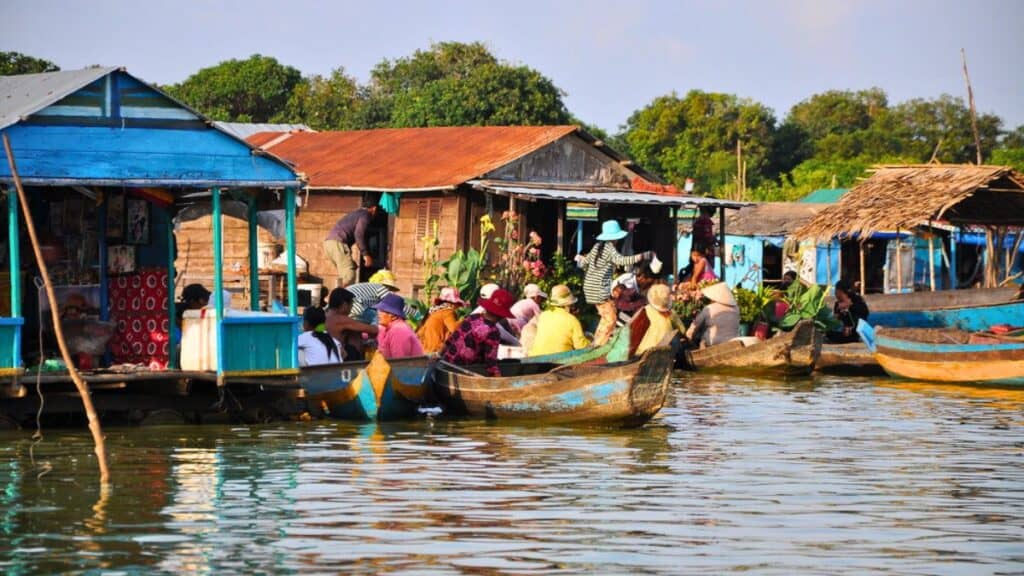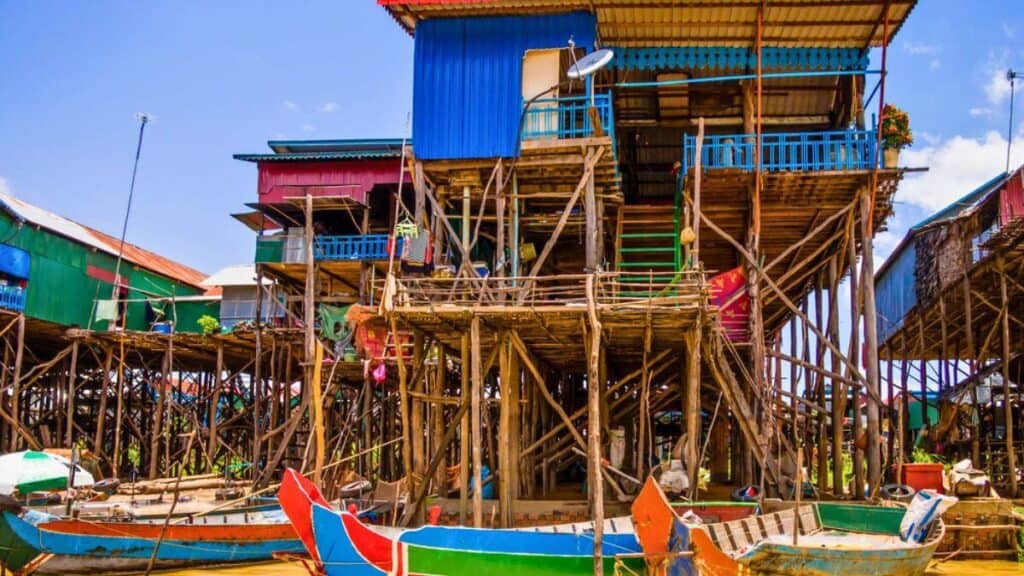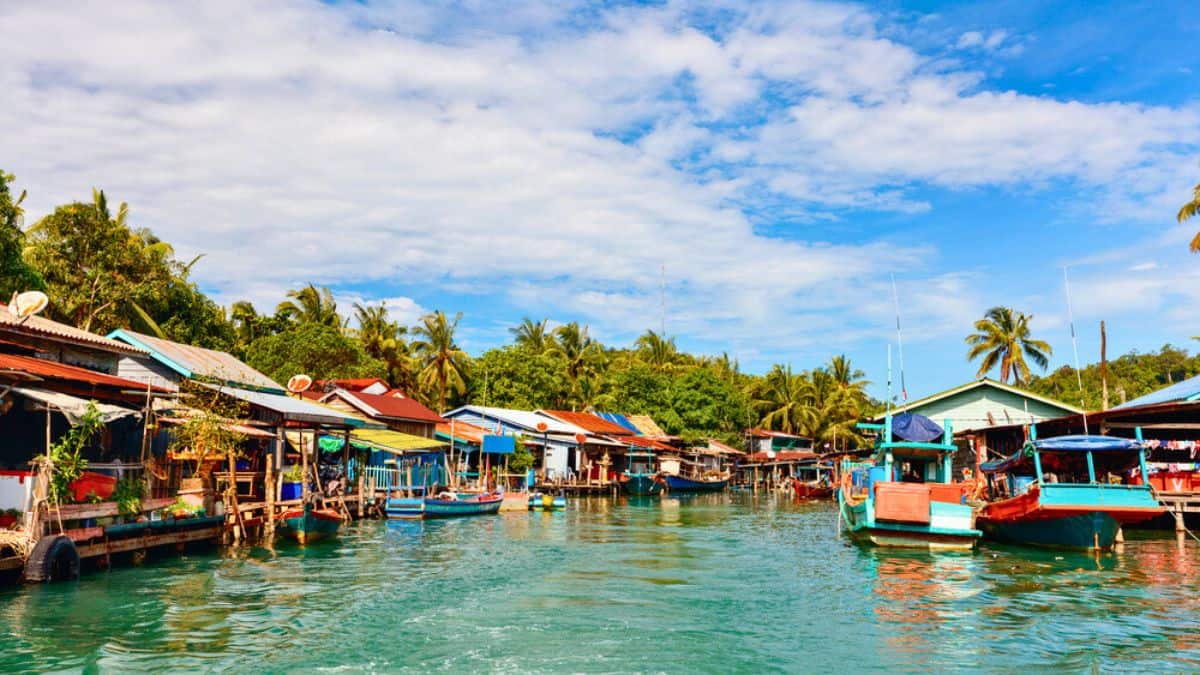Ever heard of a floating village? Care to visit a raft home or play basketball in one? Floating Village Cambodia serves as a mesmerizing window into a unique way of life. For a slightly off-the-beaten-path destination beyond the famous temples, you have to explore at least one of Cambodia’s floating villages.
In Cambodia, you’ll discover over a hundred floating villages surrounding Tonle Sap Lake, the biggest freshwater lake in Southeast Asia. These villages are home to fascinating communities where you can meet locals, learn about their culture, and see their everyday lives up close. The houses are tall and built on stilts, serving as both homes and places of business. Most villages have markets, schools, and festivals; some even feature floating basketball courts and large alligator farms.
Originally, Cambodians of Vietnamese origin were the first settlers in these floating villages, playing a vital role as the country’s main fish suppliers. Nowadays, the Cham, Vietnamese, and ethnic Khmer people also reside in these unique communities. If you’re looking for an enriching experience, adding a floating village tour to your Cambodia itinerary is definitely worth it.
How To Get to the Floating Villages
The floating villages are located at Tonle Sap, west of the Cambodian capital. Tonle Sap stretches to five provinces, meaning these water-bound communities have multiple entry points.
However, the most popular way of reaching Tonle Sap is from Siem Reap. Your transportation options to get to the floating villages include:
- Rental car or van with driver (prices vary depending on pickup point, number of people included in the tour, and season),
- Ride a taxi for 35 US Dollars going there and again going back,
- Ride a tuk-tuk for 20 US dollars per person, going back and again.
The floating villages are 9.3 miles (15 kilometers) South of Siem Reap International Airport. Reaching the boat dock from Siem Reap will take around 40 minutes to one hour or about 20 mi (32 km).
It would take another 20-minute- to two-hour boat ride from the dock to reach the villages you’ve chosen to visit.
Future Of Floating Villages in Cambodia
A few years ago, the New York Times painted a sad picture of Tonle Sap Lake, highlighting the changing situation for the floating villages due to climate change and prolonged droughts. The delicate ecosystem of the lake is undergoing significant transformations, adversely impacting the livelihoods of fishermen and threatening the sustainability of these communities.
As responsible travelers, we must recognize these challenges and actively contribute to solutions. By choosing community-owned tour operators that directly benefit the residents, we ensure that our tourist dollars are channeled into improving their lives. Supporting local businesses and engaging with the community in a respectful way means getting a deeper understanding as a visitor.
Ethics of Visiting a Floating Village in Cambodia
Floating villages in Siem Reap offer a unique glimpse into traditional life. Still, it’s crucial to approach these communities with respect and mindfulness. Remember that these are not tourist attractions; they are home to real people.
- Seek Permission Before Taking Photos: Respect the residents’ privacy by asking for permission before taking pictures of individuals or their homes. Remember, these are their homes, not just a tourist destination.
- Support Community-Owned Tours: Opt for tours operated by residents rather than large companies that profit from the village without returning any benefits. By choosing community-based tours, you ensure your money directly supports the community and helps fund vital services like schools, healthcare, and infrastructure maintenance.
- Avoid Giving Money Directly to Children: Avoid giving money directly to children, as this can create a dependency on this way to earn money, leading to begging and hindering their education or job opportunities. Instead, consider buying souvenirs or supporting local businesses directly.
- Be Mindful of Your Impact: Floating villages are delicate ecosystems. Be mindful of your environmental impact by avoiding littering and respecting the natural surroundings.
- Engage with Locals: Show genuine interest in the village’s culture and history. Engage with the locals, ask questions, and learn about their way of life. You may be shocked by the way they live.
- Respect Cultural Norms: Dress modestly and avoid behaviors or gestures that may be considered offensive in Cambodian culture.
- Choose Sustainable Practices: Support sustainable tourism initiatives prioritizing environmental protection and community engagement. Look for tours or activities that directly minimize their environmental impact and benefit the local community.
For example, the boat service in Chong Kneas and Kampong Phluk is privately owned, so the local community doesn’t benefit. In addition, in Kampong Khleang and Mechrey, the community owns the local boat service. That means the tour money benefits the local community by funding schools, medical care, and more.
4 Most Popular Floating Villages
1. Kampong Khleang
- Tour costs: Starts at $75
- Distance: 221.8 mi (35 km) away from downtown Siem Reap
- Number of Residents: Over 20,000 residents
If you must pick only one floating village, I recommend going with Kampong Khleang.
As the largest village on the lake, this place also has the most number of interesting structures. They also have several walkways leading to the temples and other parts of the village without being bound to the boat throughout the tour.
Kampong Khleang offers the most authentic floating village experience in Cambodia. You can see their gorgeous pagodas, functional schools, village clinics, flooded forest, and a picturesque mix of stilted houses and raft homes.
The downside is that it is one of the farthest from Siem Reap — you must embark on a two-hour boat ride from the Phnom Krom boat dock.
Because of its location, Kampong Khleang isn’t full of tourists. The community also owns the tour service and organizes tours, so tourism money directly benefits the residents and is used to fund medical centers or school boat drivers.
2. Mechrey
- Tour costs: Around $20 per person or $100 per boat
- Distance: 15.5 mi (25 km) southwest of Siem Reap
- Number of Residents: Around 300 families
Mechrey Floating Village is the least visited village on Tonle Sap Lake. If you paid for an eco-tour to the Core Bird Reserve, visiting Mey Chrey or Mechrey is ideal because you’re passing the village anyway.
Mechrey was just recently promoted as a floating village destination. Unlike the more famous villages, Mechrey residents earn from the tours.
If you go here, check out Adventure Travel Co.’s Meychrey tour for $82 per person. The price includes entrance fees, boat driver tips, an English-speaking guide, and tips for the villagers.
The company proudly tells its clients that Meychrey’s village chief blesses it, and the boat service is community-owned. That means that the tour money will go directly to the community, which they will use to fund local facilities. You can feel the residents welcoming you with warm smiles (instead of feeling like you’re intruding on their community).
The best part of Mechrey? There are few tourist traps here and plenty of opportunities to talk to locals, hear their stories and soak in the place’s serenity.
3. Chong Kneas

- Tour costs: $50 for Tonle Sap Lake entry and a boat tour to Chong Kneas
- Distance: 37.9 mi (16 km) away from downtown Siem Reap
- Number of Residents: Approximately 6,000 people, most of them Vietnamese
Chong Kneas is the most popular floating village since it is the closest village to the city. Hotels usually recommend this village as well.
What I like most about Chong Kneas is the colorfully-painted houses. And if you’re lucky to catch the sunset here, you will go home with a stunning photograph.
Aside from the brown and smelly waters of Chong Kneas, beware of tourist traps. The boats will stop at floating stores where people try and force you to buy school supplies for local kids or expensive grocery items ($40 for a bag of rice!) to donate to villagers. Sadly, this is a well-known scam, and the money doesn’t go to the locals.
Other common “stops” include the unethical crocodile or snake farms, where kids will ask you a dollar or two for taking a photo with their pets.
4. Kampong Phluk

- Tour costs: $35 to $60 for Tonle Sap Lake entry and boat tour to Kampong Phluk. Insurance options and additional tour stops to a temple cost extra.
- Distance: 20 mi (32 km) southwest of Siem Reap.
- Number of Residents: Around 3,500 residents (from 700 families).
Kampong Phluk, translated as “Harbor of the Tusks,” comprises three villages. Kampong Phluk has houses built higher than other villages – their stilted homes are around 20 feet (6 meters) above the ground.
Visitors still report scams when visiting the floating village, like an unethical crocodile farm or buying school supplies for extremely high prices. Also, the boat service here is owned by a private company, which means the community doesn’t see a dime.
Kampong Phluk offers a more mythical look thanks to the flooded mangrove forest that you can visit near their stilted houses. Getting to the mangroves takes an extra 30-minute boat ride, but it’s definitely worth it.
Tips to Make the Most of Your Floating Villages Excursion
- Pre-book a Tour
Pre-booking a tour in advance costs more than creating a DIY tour when you reach the dock, but this avoids unnecessary expenses.
- Bring Water
Bring as much water as you and your crew need. Avoid drinking water here. Yes, even if bottled water can be bought from floating stores.
- Pick the Best Time To Visit Cambodia’s Floating Villages
While you can visit Cambodia’s floating village whenever you want, it is best to go during the rainy season (from April to September). At this time, the Tonle Sap River changes direction, causing the lake to expand to five times its usual size. This creates the perfect opportunity for boat tours to explore the floating villages.
- Wear a Life Jacket and Sun Protection
Bring or rent a life jacket if you’re visiting the lake with a child or anyone who doesn’t know how to swim.
- Know Where Your Money Goes
If you’re coming here to support the locals, know this isn’t always the case. Research in advance to know if the tours you’re paying for will really benefit the villagers.
Income from tours of villages like Chong Kneas and Kompong Phluk goes directly to the private boat companies (and not the locals).
Meanwhile, when you pay for tours to villages like Kampong Khleang and Mechrey, they actually support the drivers and give the community another source of income.
Frequently Asked Questions – Floating Village Cambodia
What Is the Name of the Floating Village in Cambodia?
As of 2015, there were 173 floating villages. Chong Kneas, Kampong Khleang, Kampong Phluk, and Mechrey are the four most-visited floating villages.
How Many People Live in the Floating Village in Cambodia?
More than 100,000 people live in Cambodia’s floating villages. An average of two to three families reside in each of the 20,000 floating houses built around Tonle Sap Lake.
Why Are There Floating Villages in Cambodia?
The floating villages in Cambodia are linked to the country’s complicated past with Vietnam. Many Vietnamese came to Cambodia between 1863 and 1953 to work in offices and farms, living peacefully with locals and raising families. But when the Khmer Rouge took control in 1975, lots of Vietnamese were killed or had to go back to Vietnam. When they returned in the 1980s, they didn’t have Cambodian papers, so they were seen as foreigners.
Even now, many people in Siem Reap’s floating villages don’t have Cambodian IDs, so they’re stateless. People who aren’t Vietnamese sometimes can’t afford to rent or buy properties there. Others stay because they rely on fishing in Tonle Sap Lake, the biggest inland fishery in the world.
Is the Floating Village in Siem Reap Worth Visiting?
Are you visiting the floating village in Cambodia with clear expectations? Are you prepared to face a certain level of discomfort? If you answered yes to both questions, visiting the floating villages in Siem Reap is certainly a must-have, one-of-a-kind experience.
However, I’m not saying this experience would be good for everyone. Your trip outcome will depend on the village you choose to visit, the travel agency or tour package you paid for, and your own expectations.
Conclusion – Floating Village Cambodia
Floating villages in Cambodia are unique and resilient communities that have adapted to the country’s watery landscape. These settlements, built on stilts and anchored to the riverbed, provide a way of life for thousands of Cambodians who rely on fishing, agriculture, and tourism for their livelihoods. The villages face challenges like climate change, pollution, and urbanization, but their inhabitants continue to thrive, showcasing their rich culture and traditions.
Your Ultimate Travel Guide & Booking Resources
Skyscanner is my trusted ally for booking flights, guiding me to the perfect travel options while making the journey planning process a breeze with its user-friendly interface and extensive search capabilities.
12Go Asia is my ultimate travel companion in Asia, offering the best budget service platform for seamless booking of trains, buses, ferries, and flights, ensuring every adventure unfolds smoothly and effortlessly.
Booking.com is my ultimate lodging partner. It offers many accommodations worldwide and simplifies my travel experiences with its user-friendly platform and unbeatable deals.
Get Your Guide is my go-to for personalized travel experiences, enriching my journeys with unique tours and activities curated to my interests, making every adventure unforgettable and tailored to my preferences.
SafetyWing is my peace of mind on the go, offering comprehensive travel medical insurance with affordable plans and hassle-free claims, ensuring I can explore the world worry-free, knowing I’m protected wherever I roam.
LifeStraw Go Bottle is my trusted hydration companion for outdoor adventures, filtering water on-the-go to keep me safe and hydrated, ensuring every hike or travel experience is worry-free and enjoyable.
Related Reads:
- Sihanoukville, Cambodia: Best Of What The City Has To Offer
- Kampong Cham Cambodia: 18 Wonderful Things To Do
Founder of Spark Nomad, Radical FIRE, Copywriter
Expertise: Personal finance and travel content. I’m a full-time traveler, and I’ve been to 49 countries and 5 continents.
Education: Bachelor of Economics at Radboud University, Master in Finance at Radboud University, Minor in Economics at Chapman University.
Over 200 articles, essays, and short stories published across the web.
Marjolein Dilven is a journalist and founder of Spark Nomad, a travel platform, and Radical FIRE, a personal finance platform. Marjolein has a finance and economics background with a master’s in Finance. She has quit her job to travel the world, documenting her travels on Spark Nomad to help people plan their travels. Marjolein Dilven has written for publications like MSN, Associated Press, CNBC, Town News syndicate, and more.

